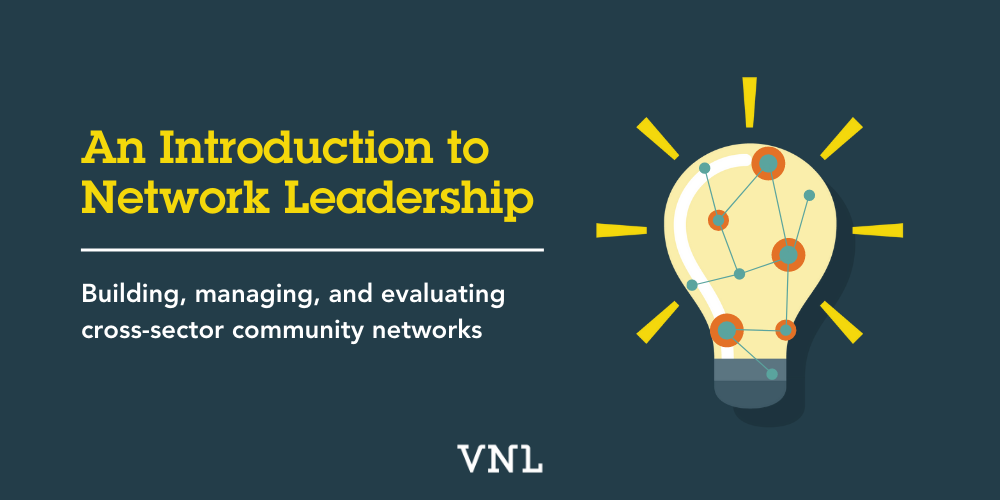
Introduction to Network Leadership: What Is It?
Network Leadership is the practice of building, managing, and evaluating cross-sector community partnership with a network approach. While traditional leadership emphasizes hierarchal styles of leadership, network leaders must manage a dynamic environment without formal roles, hierarchies, or authority.
There are a lot of common examples of network leaders:
- Coalition builders who bring together different groups to campaign for change
- Evaluators who analyze an alliance to help them improve their processes and outcomes
- Managers of backbone organizations or associations that help networks operate
- Anyone who maintains and leverages a network of community partners to create social impact
In this introduction to network leadership you’ll learn about some of the key skills, concepts, and values that define network leadership, along with strategies you can apply to your own networks.
The Foundation of Network Leadership are Key Seven Values
Network leaders deal with many ethical and value-based questions in their line of work. Moral quandaries are everywhere, as the way a network forms, operates, and evaluates its work is all embedded in multiple value systems that often conflict or diverge. Network leadership is values dependent. Here is our list of network leadership values.
- Diversity, equity and inclusion
- Community and cultural sensitivity
- Relationship focused
- Skills based
- Data-driven
- Reflective
- Adaptive
Skills for Building Networks
A network leader’s job starts by building a network. Sometimes this happens formally as someone receives funding to build a new network. However, more commonly it happens slowly and informally as community organizations form a web of partnerships over time. At some point, the network is acknowledged and formalized – another way networks are built. Network leadership skills for building networks includes:
- Creating partnerships with community individuals
- Forming effective one-on-one professional relationships
- Facilitation and group engagement skills
- Knowledge of common network types and structures
- Building diverse, equitable, and inclusive partnerships
A network leader ideally is able to identify potential or current network members, catalyze their engagement around a common goal or values, design a strategic structure for their network context, and build in considerations of diversity and equity throughout the entire process. The ability to map the network as it exists compared to how it should exist is an extremely helpful tool at this stage.
Skills for Managing Networks
Once the network has formed, adopted goals, and started to operate on a day-to-day basis, network leadership becomes about managing the network’s membership, resources, activities, and engagement. More time will go into facilitation and group discussion than in a normal organization due to the lack of formal authority and multiple (often conflicting) perspectives. Network leadership skills for managing networks includes:
- Conflict resolution and negotiation
- Facilitation and group engagement skills
- Building trusting relationships
- Identifying and leveraging shared resources and value
- Communicating effectively with diverse partners
Network management is more collaborative in nature than traditional forms of management which rely on authority, and when needed, force. Networks almost always rely on voluntary collaboration, so managers must take time to hear all perspectives and build consensus. Experience building compromises and forging agreements is highly valued for exemplary network leadership.
Skills for Evaluating Networks
At all stages of a network’s lifecycle, network leaders should be evaluating their process and outcomes to learn and improve their network. We recommend taking a network science approach to evaluate your network using social network analysis. This involves asking the members of your network who they work with, along with trust, value, and other attributes, to map the structure and quality of their partnerships. Network leadership skills for evaluation include:
- Social network analysis and network science
- Survey design and analysis
- Creating and adapting a network strategy
- Translating data into actionable insights
- Using your data to tell your network’s story
Surveying your members regularly (like twice a year) allows you to see how your network is changing, identify gaps and opportunities, and build a better strategy for your network. There are other methods for evaluation too that can be used instead or in addition to a social network analysis. This includes interviews and traditional survey research, program-based evaluations, and different network evaluation frameworks. The key is finding the method and framework that works best for your network – every network has a unique history, community, and context that may affect your decisions.
More Network Leadership Resources
Looking for more information beyond this introduction to network leadership? Visit our network leadership resource library. These additional websites and resources cover more network leadership-related topics. Have a suggestion for a resource to add? Leave a comment below and it might make it into the list during our next revision to this guide.
- Network Weavers: This site offers resources and discussion space for those who want to better understand network approaches to transformation and improve their skills in facilitating this transition.
- Converge Network Toolkit: A great list of templates, guides, and worksheets useful for building, managing, and evaluating networks.
- New Leadership Network Resources & Tools: This is their curated list of favorite resources and tools related to transforming a community’s future through networked action.

About the Author: Alex Derr, M.P.A.
Director of Marketing & Communications
Alex joined VNL in 2017, originally supporting our events. He now helps manages our communications and marketing strategy and content development work. Alex creates blogs, infographics, reports, and other content while managing our web and social media presence. He also runs our email marketing campaigns, tracks analytics, and conducts market research to drive our strategy. He supports our entire team with copywriting, graphic design and research, and helps with events, webinars, demos, and other online learning. When he isn’t at work Alex spends his time climbing 14ers (30 done, 28 to go!) and blogging on his own website, The Next Summit Blog.




